|
|
|

|
|
|
:: Bubbling Well
:: Chi (Breath, Vitality)
:: Chi Kung (Excellence of Energy) ::
:: Ching (Essence) :: The Classics :: Feng Shui (Wind/Water) :: Five Elements :: :: Internal Martial Art :: Principles :: :: Push Hands :: :: Shen (Spirit) :: :: Sung (To Sink) :: T'ai Chi Trunk :: Tan T'ien (Lower) :: Taoism :: :: Three Treasures :: Traditional Chinese Medicine :: Wu Chi :: Yin/Yang :: |
|
| Bubbling Well | |
|
The importance of this point in T'ai Chi practice is multi-faceted. In terms of a postural and balance guide, the idea is that when the weight falls properly on this point one has aligned the weight of the upper body correctly in respect to the base of the lower body. The feeling of this correct alignment is that the foot, even of a weight bearing leg, should be soft and relaxed. It's interesting to note that most of our muscular usage (some tests say as much as 80%) is compensation for poor balance. So as our balance and posture improve, we become more efficient in our muscular use, not only conserving energy, but also freeing the body to move which is a prime contributor to the strength element in T'ai Chi. The awareness of the desired feeling of the foot being soft and relaxed is one of the most important indicators of this correct body relationship. On the energetic level, the Bubbling Well represents the gate that either permits or inhibits the "Earth Chi" from rising up and entering the body. One again the prime factor here is balance. If the balance is good, the foot relaxes and the energy is permitted to flow into the body. If the balance is poor and the foot is tense, then the energy is blocked. This actually describes a very important aspect of T'ai Chi both as a martial art and a personal growth tool. The importance of Chi § or vitality is understood in all aspects of the practice, but the quality that ultimately determines how much Chi one accesses is not force or effort or desire, but balance. So one can only draw the amount of energy that one is capable of using well.Grandmaster Cheng, Man-ching taught that T'ai Chi Ch'uan was the study of what he called the "Three Treasures" § which were the Bubbling Well, the Tan t'ien, § and the crown of the head. The Bubbling Well is our earth connection where we establish that quality referred to a having "root". So in many respects, this is the foundation of our practice and must be given much consideration and emphasis. |
|
| ^Index | Chi (Breath, Vitality) |
|
For example, a doctor of Traditional Chinese Medicine § never treats the physical body as the prime cause, although he may use the symptoms of the body to help diagnose what is wrong. The understanding is that what is wrong is not primarily a bodily ill, but rather what's wrong with the Chi or energy. Using acupuncture, herbs, and therapeutic movement (T'ai Chi and Chi Kung), the physician seeks to alleviate any blockages that may be interfering with the flow of Chi . The idea is that when the Chi is once again balanced and circulating well, then physical symptoms disappear.In T'ai Chi as a healing art, the movements are primarily a joint oriented body study. The Chinese call the joints "gates", and as such they control the amount of Chi that flows through the body. The physical action of T'ai Chi practice is designed to increase the range of movement in the joints and unblock muscular tension, therefore enhancing the circulation of the Chi so that it moves effortlessly throughout the entire body. From the perspective of this study, one's health is primarily determined by the balance, strength, and circulation of one's Chi . Even though this energetic element of our life experience is difficult, maybe impossible, to measure (unlike blood pressure or other purely physical expressions), we all have the undeniable experience of those days when we feel light, positive, and energized, versus those days in which we feel heavy, depressed, and fatigued. This is a direct experience of the quality of our Chi. |
|
| ^Index | Chi Kung (Excellence of Energy) |
|
As one might assume, recognizing the length of time involved (5000 years), there is an extraordinary range of exercises and practices contained under this heading. Some are stretching and limbering, some are primarily breath oriented, some are very quiet and meditative. But underlying all of these very diverse practices is the unifying element that they are dedicated to enhance the energetic level, the Chi, as their primary goal.
When I was in China I was taught by my teachers that it was considered good procedure for a doctor to use Chi Kung exercises to help a person get to the point where they could then do T'ai Chi practice, and to view T'ai Chi as the ultimate health maintenance system. Now this is not to negate the importance of Chi Kung, such as standing practice, as a powerful meditative tool for personal growth and a developer of specific qualities such as rooting. Certainly in the repertoire of the student of Internal practices there should be room and usage of a blend of T'ai Chi and Chi Kung, for really, T'ai Chi is Chi Kung, and Chi Kung is T'ai Chi.
|
|
| ^Index | Ching (Essence) |
|
Ching is recognized as the basic fire of the body. It has a direct relationship to sexual energy which in Taoist practice is understood to be both creative and procreative. Taoism § is a very methodical approach to health and personal growth, and the nurturing of the Ching energy in the Lower Tan t'ien is in many ways the laying of the foundation for all subsequent improvement both physically and energetically.
T'ai Chi practice, especially the martial art aspect of the study, goes on to distinguish between various expressions of Ching. Examples of this are Peng Ching (expansive energy), Ting Ching (listening energy), and Fa Ching (emitting energy). Each of these, as well as others, are energetic abilities that express different master level skills. Certain styles might give more emphasis to one form of Ching over another, but each is the result of being successful in cultivating the internal energetic levels of T'ai Chi Ch'uan. Professor Cheng, Man-ching, the late Grandmaster of T'ai Chi, felt that the cultivation of this aspect of practice was so important that he taught that "concentration in the Tan t'ien is worthy of being a 24 hour a day practice". It should be understood that the true intention of the practice of T'ai Chi is to open the heart (Middle Tan T'ien Chi energy) and calm and clarify the mind (Upper Tan T'ien Shen energy), and yet to accomplish these goals requires the development of a strong Ching. |
|
| ^Index | The Classics |
|
Starting with Chang Sang-feng, legendary founder of T'ai Chi , and down through the centuries, masters have described and developed their personal understanding of the principles § of the practice. This insight into the principles of T'ai Chi is what is so important about these traditional writings. Not once in all of these essays and poems (and granted, there aren't that many) is there mentioned the idea that one style is better than another even though the Classics contain writings from proponents of all T'ai Chi styles. The emphasis is completely on the understanding and development of principle, which is exactly where it should be.
The value of the Classics is not meant to negate the importance of studying directly with a qualified teacher. It is my personal experience to have learned more from simply feeling the touch of a true master's hand on my body than I will ever learn from reading. But I also feel that the nature of T'ai Chi teaches us to take advantage of any and all learning opportunities. Certainly the Classics represent one of these learning opportunities. |
|
| ^Index | Feng Shui (Wind/Water) |
|
Today, Feng Shui is growing in popularity in the West as element of what I might consider conscious interior design. The art describes how to maximize room layout in respect to directional reference and use of implements such as mirrors, plants, and other positive devices, all for the purpose of enhancing the living or work environment. And while this is certainly a viable use of the art, I feel that it is important to take into consideration the broader scope of the study which is to understand that as an individual is presented with an immense amount of cosmic influence or energy. To the degree that one understands this, and has the skill to take advantage of it well, one appreciates the study of Feng Shui. |
|
| ^Index | Five Elements |
|
The basic idea is that everything is made up of some combination of these elements, and therefore expresses the traits or tendencies implied. If one were to look in traditional Chinese medical texts, one finds long lists of categories ascribed to each of these elements. The breakdown into these categories includes the seasons, foods, personality and body types, colors, sounds, smells, and just about anything else that you can think of. For example, in color, fire is red, earth is golden-brown, metal is white, water is blue-black, and wood is green. In the body, fire is the heart-small intestine, earth is the spleen-stomach, metal is the lungs-large intestine, water is the kidneys-urinary bladder, and wood is the liver-gall bladder. So what is the value of this life model? What are its practical applications? The ancient Taoists felt that we, as humans, were unique in that our need and potential was to create a balance of all five elements in order to achieve maximal health. Through diet, attunement to our environment, and movement practice, one has the opportunity to access these energies. In Traditional Chinese Medicine § a doctor both diagnoses and treats a patient in respect to the model of the Five Elements. Through listening to the pulses, determining one's constitutional elemental type (one is understood to be predominately either fire, earth, metal, water, or wood), and observing pysiogomy (facial diagnosis), a doctor determines if there are imbalances within the patient in respect to the Five Elements; too much fire, too little water, and so on. The treatment, either through acupuncture, herbs, or movement practice is intended to support a process of allowing the individual to return to a state of energetic elemental balance.The understanding of the Five Elements can lead to great sophistication and subtlety, as is my experience with both Chinese doctors and T'ai Chi masters that I have meet. But in general anyone can begin by understanding the basic characteristics of each of the elements. Fire is the primary creative force of life. The positive movement between the Five Elements, what is called the Creative Cycle begins with fire. It is dominant Yang and represents warmth, light, and the initial spark of life. It in turn leads to earth. Earth represents all that we think of as substantial, enduring, and persevering. Next comes metal. People often ask "Where's the air element?" In the Taoist view, the metal element is very similar to air. It includes the lungs as its organ, but in general represents the process of transforming something that is base and impure into something that is pure and strong. An example is that of forging iron into steel. The next element is water which is archetypal Yin . It is all that is soft, fluid, and continuous. Last is wood who's image is that of the blade of grass or the bamboo shoot. It represents suppleness and the ability to yield well in the face of force or aggression. It completes the elemental cycle and in turn reconnects back to the point of origin, fire. |
|
| ^Index | Internal Martial Art |
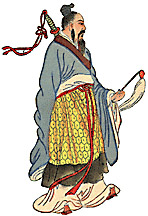
Although other T'ai Chi practitioners may disagree with me, I feel that T'ai Chi as a martial art has virtually nothing to do with learning self-defense, although these skills can be developed in the practice. Rather I have been trained to understand the martial art aspect of T'ai Chi , which includes study of application, push-hands, § and full contact sparring, to be the use of intense and demanding situations to observe old patterns of reacting with fear and aggression, and systematically replacing them with awareness and relaxation.My teachers, all native Chinese and truly accomplished martial artists, seem to share one basic skill; freedom from fear. If I have experienced one core benefit from the martial aspect of T'ai Chi training it has been a lessening of fear (fear of pain, fear of injury, fear of the future) which leads to a sense of calm confidence. This is the emotional component of the ability to respond well to demanding situations and an aspect of true martial art proficiency. |
|
| ^Index | Principles |
|
These principles have been handed down both orally and through the traditional writings of T'ai Chi which are collectively referred to as the Classics. § They include an emphasis on relaxation of tension, both physical and mental, leading to the development of internal strength; a process of integration in which the mind and body become unified; and an unshakable understanding that the key element in respect to any life success is the maintenance of the qualities of balance and harmony.Styles come and go. Form is of value only in respect to the opportunity it presents in allowing insight into something more essential. The emphasis that T'ai Chi places on principles, and their sense of timelessness in the midst of constant change, is truly the key to the practice of T'ai Chi being an "internal study". |
|
| ^Index | Push Hands |
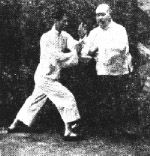
Initially Push Hands is done with the idea of being a two person form, meaning that there is a set pattern of complimentary movements in which one person does a forward/Yang movement while the other person is receptive/Yin. The roles then reverse allowing for balance. This permits the student to begin to experience directly, through the body experience, the feeling of alternating Yin and Yang § movements and expressions, maintaining a sense of balance both within oneself as well as within the relationship. Push Hands, despite the popularity of contests and competitions over the past years, is not meant to be competitive. In good Push Hands, both participants win, nobody loses.
I teach that one of the great benefits to be derived from Push Hands is a redefining of what might be termed "true Yin" and "true Yang". In our culture we have very poor role models for each of these. Yin is often viewed as victimized and weak, while Yang is forceful and aggressive. In T'ai Chi the idea of Yin is defined as "moving towards strength", while the attributes of Yang are most often described as generosity and gentleness. Certainly this implies a tremendous shift of attitude, and Push Hands is the means by which to accomplish much of that. |
|
| ^Index | Shen (Spirit) |
|
When one has regained the awareness of Shen , one has cultivated the calm alertness that permits the Mind to express its two primary qualities; insight and overview. These two qualities allow an individual to operate from a perspective larger than the one usually permitted by one's personality. In the Orient this perspective is sometimes referred to as having a "Big Mind". |
|
| ^Index | Sung (To Sink) |
|
The intention of sinking is, as is the case for many T'ai Chi principles, § a multifaceted expression. The major elements involved in this process of sinking include aspects of mind, energy, and weight.The sinking of mind is related to the idea of attention in the lower Tan t'ien, § or pelvic area. This denotes the relaxing of the attention usually held in the head, shoulders, and chest , allowing it to settle down to the Tan t'ien . The result of this is a shift out of being top-heavy (and thought oriented) into the experience of bring centered (feeling/sensory oriented).The sinking of the energy is directly related to that of sinking the mind, and in many ways is the result of being successful in being able to do so. The Classics § tell us that "where the mind goes, the Chi follows". The result of being able to sink the energy is that we truly enliven the pelvic area as the foundation of our energetic body. This is considered the lighting of the body's fire which warms and nurtures, thus providing the basis for health in the organs, spinal column, and sensory organs.
It is important to make a certain distinction between relaxing and that of sinking. One could conceivably relax into a state of flaccidity or weakness. Yet in the process of sinking, in which we include the understanding of suspending the head top and muscular tone, one can only release the body, energy, and mind into a state of awareness, freedom of movement, and dynamic, non forceful strength. |
|
| ^Index | T'ai Chi Trunk |
|
The understanding of this principle is that when these three upper body parts are used independently, the result is the poor movement patterns of bending, leaning, and twisting, which literally break the body apart. These poor movement patterns, understood as repetitive actions performed hundreds of times a day, have a tremendously stressful cumulative effect on the body. Wherever the trunk breaks becomes a place of stress and tension, the two most common locations being the lower back and the neck. Poor trunk position also has a detrimental affect on the performance and health of the organs. As one develops a feeling for the T'ai Chi trunk, one eliminates the old pattern of breaking into pieces. The new sense of the trunk movement is that one moves from the pelvis (Tan t'ien), § and as the pelvis moves, so do the shoulders and head. When the pelvis stops or reaches its fullest range of movement, the shoulders and head also stop.The complete understanding of the T'ai Chi trunk incorporates a sense of moving from center (the Tan t'ien), integration of the upper body (hips, shoulders, and head), and a feeling for a vertical trunk which in T'ai Chi is always understood to mean the body's position in respect to gravity. |
|
| ^Index | Tan T'ien (Lower) |
|
While the ability to actually drop the attention into the Tan t'ien yields some significant physical benefits, the most important and challenging aspect of this principle is to create a shift of attention away from a thinking orientation to a feeling one. The study of T'ai Chi is one of broadening our understanding of our true capabilities and perception of life in general. While thought process is a wonderful aspect of mental function, in T'ai Chi it is understood to be just one of a broad range of possible skills which all fall under the general heading of Mind. Being centered in the Tan t'ien implies the intention to give one's sole attention to the experience of this moment without the distractions of thoughts concerning either past or future events. When Grandmaster Cheng, Man-ching was asked how he would recognize a senior student of T'ai Chi , his answer was "One round of form, no distracting thoughts". The result of this strong, unbroken attention is the state of a calm yet exceptionally alert mind which is referred to as Wu Chi, § the experience of the true master of T'ai Chi. |
|
| ^Index | Taoism |
|
T'ai Chi expresses the attempt to express in physical, energetic, and mental movement the principle § which Taoists throughout the ages have observed as the basis of all life; balance within a process of constant change. Through the practice of simple body mechanics such as shifting weight or taking a step, one gains insight into the principles which govern all movement.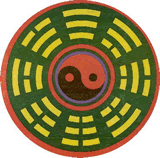
One of the timeless principles of Taoist perspective has been that of the relationship between the Microcosm and the Macrocosm; the inner experience and the outer reality. The observation is that the laws that govern one are the same as those that govern the other. Through the use of simple body movements one becomes more aware of the principles of all movement whether it be the shifting of one's weight, the breeze blowing a cloud across the sky, or the orbit of the planets around the sun. |
|
| ^Index | Three Treasures |
|
The Three Treasures are given the Chinese names of Shen, § Chi, § and Ching. § These represent three expressions of one's true nature in respect to different aspects of our multi-faceted being. The Shen , said to be located in the Upper Tan t'ien or head, means "spirit", and denotes the higher faculties of mind (both intellectual and intuitive). The Chi, or "breath", is located in the Middle Tan T'ien or heart center, and denotes one's relationship with worldly activities (communication and relationships). The Ching, or "essence", is located in the Lower Tan T'ien or pelvic center, and represents one's basic body center and energetic foundation.The definition in the Chinese culture of the "superior person" is that individual in which all Three Treasures, or Tan t'iens, are healthy, strong, and in good relationship with each other. In a very real sense it describes a person who is strong and healthy in body, emotions, and mind, all of which contribute to a strength of spirit. One definition of a master in T'ai Chi is "that person who thinks, feels, and does the same thing". In our T'ai Chi practice the emphasis is placed initially (and possibly for a number of years) in the Lower Tan t'ien because this is understood to be the foundation upon which the other two energetic centers are built. The understanding is that the Ching is the basic fire which needs to be strong and warm. All to often, due to poor diet, poor exercise habits, and wasteful sexuality, this lower fire becomes weak. This is considered in Traditional Chinese Medicine § to be a major contributor to many of the conditions that both men and women experience as they enter mid-life. So the remedy is to keep this Lower Tan t'ien fire strong through good mental focus, movement practice, and diet.This in turn begins to have a beneficial affect upon the other two treasures of Chi and Shen. The Taoist approach is very methodical. It is like building a house; first you lay a strong foundation, then build the walls, and finally the roof. The Ching is the foundation, the Chi is the walls, and the Shen is the roof. Achieving this state of richness in the Three Treasures is what would be considered "mastery" in the Taoist tradition. |
|
| ^Index | Traditional Chinese Medicine |
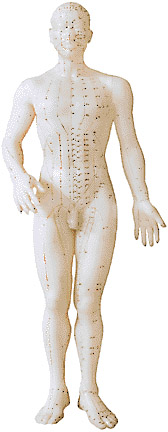
Chinese medicine is composed of three primary modalities; acupuncture, herbology, and therapeutic movement (Chi Kung and T'ai Chi). It's emphasis is placed on an ideal of preventative medicine, an approach that is health oriented rather than disease oriented. It is interesting to note that in ancient China one paid a doctor for keeping one healthy, but if illness occurred, treatment was free. In respect to its therapeutic process, Chinese medicine views disease as merely symptomatic; physical expressions of imbalance taking place on the energetic level. Likewise, treatments, even those administered to the body, are directed to the chi or energetic body. So regardless of whether the physician uses acupuncture, herbs, or T'ai Chi as the technique of choice, the intention is always to nurture a state of enhanced circulation and balance of the energy. There is a fundamental understanding in Chinese medicine called the "Inherent Principle". This principle, simply stated, says "Life moves in a positive direction, get out of the way". This implies the idea that what we need to do in many, if not most, health related situations is release the blocks and tensions that we have constructed and that interfere with natural movement, physical, energetic, and mental. In Chinese medicine a doctor does as little as possible, always aware that they're working with a natural process to support an experience of balance and harmony. |
|
| ^Index | Wu Chi |
|
Lao Tzu taught the principle of "Wu Wei " which is the essence of the state of Wu Chi. Wu Wei is described as the "action that comes from non-doing". Once again a difficult idea to discuss, but possibly one that each of us can identify with in some past experience of being in just the right place, at just the right time, with just the right action. In such an situation there is the sense of doing very little but accomplishing a lot. This would be a touch of Wu Chi. For many of us raised in Western culture the philosophy and life strategy of T'ai Chi is very different than our upbringing. In fact I feel that one of the primary benefits of T'ai Chi is on the level of challenging attitudes and past conditioning. These old conditionings cause us to view life ina very limited way. For example, one of the basic tenets of Western culture is that of work ethic. We are taught to work hard, placing the emphasis on what one does, one's actions. How very different than the Taoist emphasis which is placed on who one is, one's state of being. The feeling is that when that state of inner being is balanced and calm, then one is productive without a great deal of doing or effort. This hints at the master level of accomplishment known as Wu Chi. |
|
| ^Index | Yin/Yang |
|
The law of Yin and Yang describes that in the phenomenal world (both physical and energetic) all experience is expressed in a state of relationship between complimentary but opposing pairs. So we see the relationship between winter/summer, night/day, female/male, negative/positive, and a countless list of others. In our lives Yang represents all that is expressive, productive, and strength oriented. On the other hand Yin is receptive and internal. The recognition of this life principle § is understood to be at the foundation of health, skillful movement, and general productivity.
T'ai Chi is described in the Classics § as the study of "separating the Yin and the Yang ". My interpretation of this teaching is that in life, to be truly productive, one must be either fully Yin or Yang according to the need of the situation. We feel stuck, confused, or unproductive when we get caught in the gray zone of being neither Yin or Yang, or choose the wrong expression entirely. In T'ai Chi this is referred to as being "double weighted" in the sense that one gets caught in a 50-50 weight distribution which, surprisingly to many, is the weakest of all possible positions. This is because there in no distinction in the body as being either Yin or Yang. In life we don't want to be double weighted.The intention is to be sensitive to the needs and demands of our situation, and accordingly, respond with a correct expression of being either fully Yin or Yang. If the situation is Yin, we respond by being Yang. If the situation is Yang, we respond with Yin. The goal is always to maintain a state of balance and harmony within the framework of Yin and Yang. In Taoist practice this is truly the only essential goal in life. |
|
|
|
|
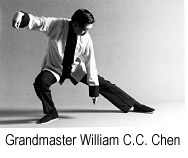 Quite frequently people ask me what the relationship between T'ai Chi Ch'uan and Chi Kung is. My answer is usually that good T'ai Chi is Chi Kung in that it too is primarily energetic in nature and is dedicated to the balancing, strengthening, and circulating of the Chi. But there are a few differences between the two. First, T'ai Chi Ch'uan carries with it the unmistakable influence of its traditional use as a martial art, while Chi Kung was practiced exclusively for its health and spiritual benefits. Secondly, as is the case in all Chinese medicine, there is the distinction between that which is a specific medicinal remedy and that which is considered a tonic. Many Chi Kung exercises are very specific in that they address particular systems, be they energetic or physical, and their related diseases or imbalances. T'ai Chi rather falls under the heading of a tonic which is defined as "that which nurtures the whole".
Quite frequently people ask me what the relationship between T'ai Chi Ch'uan and Chi Kung is. My answer is usually that good T'ai Chi is Chi Kung in that it too is primarily energetic in nature and is dedicated to the balancing, strengthening, and circulating of the Chi. But there are a few differences between the two. First, T'ai Chi Ch'uan carries with it the unmistakable influence of its traditional use as a martial art, while Chi Kung was practiced exclusively for its health and spiritual benefits. Secondly, as is the case in all Chinese medicine, there is the distinction between that which is a specific medicinal remedy and that which is considered a tonic. Many Chi Kung exercises are very specific in that they address particular systems, be they energetic or physical, and their related diseases or imbalances. T'ai Chi rather falls under the heading of a tonic which is defined as "that which nurtures the whole".
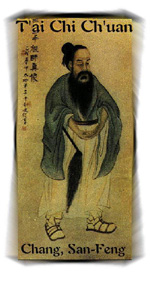 The pelvic area is the energetic center of a larger portion of the body that includes the legs, feet, and feeling of being connected to the ground. So the Chinese viewed this as the "earth domain" of the body which denotes a quality that is enduring and steady, like the earth itself. So in our T'ai Chi we incorporate a number of practice
The pelvic area is the energetic center of a larger portion of the body that includes the legs, feet, and feeling of being connected to the ground. So the Chinese viewed this as the "earth domain" of the body which denotes a quality that is enduring and steady, like the earth itself. So in our T'ai Chi we incorporate a number of practice 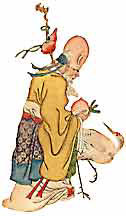 It is through the teaching of the Classics that we have a bridge across the centuries that enables us to limit the loss of information that can take place over generations. Not every student is as talented as their teacher, and not every master of the art is talented as a teacher. If these instances were the case over a number of generations (which certainly has occurred) then the result would be an irreparable loss of information. With the Classics we have the opportunity for any student to refer back to these truly timeless masters and take advantage of their wisdom.
It is through the teaching of the Classics that we have a bridge across the centuries that enables us to limit the loss of information that can take place over generations. Not every student is as talented as their teacher, and not every master of the art is talented as a teacher. If these instances were the case over a number of generations (which certainly has occurred) then the result would be an irreparable loss of information. With the Classics we have the opportunity for any student to refer back to these truly timeless masters and take advantage of their wisdom.
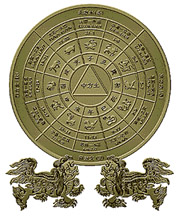 Traditionally, a Feng Shui master was called on to perform a broad range of community oriented functions, from selecting auspicious dates for various ceremonies like marriages and business openings, to defining whether specific pieces of land were energetically sound. Much of the esoteric aspect of Feng Shui is "earth Chi" related in that it implies the ability to understand the way energy flows through the earth. This skill to perceive energy flowing through the earth, what the Chinese call "Dragon veins", is similar to T'ai Chi where we seek to feel the energy flow through our bodies. With this skill, a Feng Shui master would select the proper positioning of houses, barns, and other structures correctly in respect to these earth energetic meridians.
Traditionally, a Feng Shui master was called on to perform a broad range of community oriented functions, from selecting auspicious dates for various ceremonies like marriages and business openings, to defining whether specific pieces of land were energetically sound. Much of the esoteric aspect of Feng Shui is "earth Chi" related in that it implies the ability to understand the way energy flows through the earth. This skill to perceive energy flowing through the earth, what the Chinese call "Dragon veins", is similar to T'ai Chi where we seek to feel the energy flow through our bodies. With this skill, a Feng Shui master would select the proper positioning of houses, barns, and other structures correctly in respect to these earth energetic meridians.
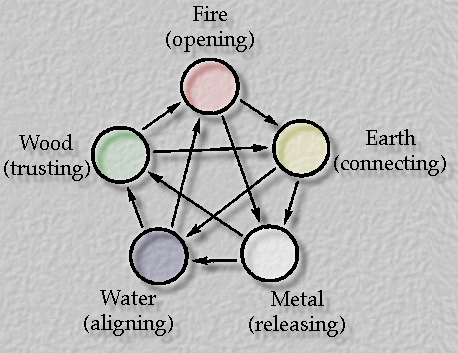
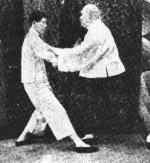 As the practice advances, the challenge grows in that the forward/Yang move becomes deeper and more penetrating. This requires that the receptive/Yin person be willing and able to move accordingly, which in T'ai Chi is called "yielding". This quality of yielding is central to Push Hands and T'ai Chi in general because it is intended to teach a student the ability to let go of anything that is none essential in respect to the need to respond to the force or Yang energy. It is important to emphasize the idea of giving away everything that is none essential. In Push Hands one is never asked to give away one's center, root, integrity, or well being.
As the practice advances, the challenge grows in that the forward/Yang move becomes deeper and more penetrating. This requires that the receptive/Yin person be willing and able to move accordingly, which in T'ai Chi is called "yielding". This quality of yielding is central to Push Hands and T'ai Chi in general because it is intended to teach a student the ability to let go of anything that is none essential in respect to the need to respond to the force or Yang energy. It is important to emphasize the idea of giving away everything that is none essential. In Push Hands one is never asked to give away one's center, root, integrity, or well being.
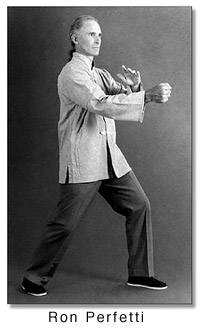
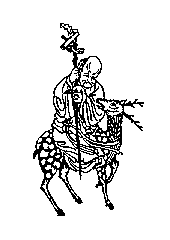 In a practical sense, Wu Chi represents a sense of stillness within movement. There is an actual experience of being able to move utilizing qualities of ease, timing, and balance in which the experience is very dynamic, and yet essentially, at one's core, there is a feeling of stillness. In the
In a practical sense, Wu Chi represents a sense of stillness within movement. There is an actual experience of being able to move utilizing qualities of ease, timing, and balance in which the experience is very dynamic, and yet essentially, at one's core, there is a feeling of stillness. In the 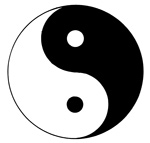 In a practical sense, we are presented with the idea that Yin and Yang represent the two life skills that we need to develop equal access to and ability in; to express and generate movement and energy in the Yang experience, and to receive energy and yield in the Yin. Both are equally important and each supports the other. Truly healthy Yang does not exist by itself but is constantly expressing itself in relationship to Yin. The same is true for the Yin qualities.
In a practical sense, we are presented with the idea that Yin and Yang represent the two life skills that we need to develop equal access to and ability in; to express and generate movement and energy in the Yang experience, and to receive energy and yield in the Yin. Both are equally important and each supports the other. Truly healthy Yang does not exist by itself but is constantly expressing itself in relationship to Yin. The same is true for the Yin qualities.